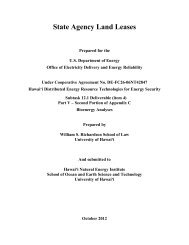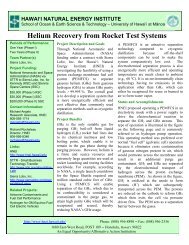Oahu Wind Integration Study - Hawaii Natural Energy Institute ...
Oahu Wind Integration Study - Hawaii Natural Energy Institute ...
Oahu Wind Integration Study - Hawaii Natural Energy Institute ...
Create successful ePaper yourself
Turn your PDF publications into a flip-book with our unique Google optimized e-Paper software.
much smaller in size relative to the wind plant resources evaluated. These smaller, distributed<br />
solar PV resources are interconnected to the distribution system whereas the analyses in this<br />
study focused exclusively on the transmission system to evaluate system-wide impacts<br />
associated with the balancing of generation and load. A comprehensive study of both the<br />
distribution and transmission system is required to analyze effectively the system-wide impacts<br />
of integrating high levels of solar PV resources on <strong>Oahu</strong>. Also, note that the historical data<br />
necessary to conduct a comprehensive solar integration study for the <strong>Oahu</strong> system does not exist,<br />
and must be developed.<br />
In parallel with this effort, the <strong>Hawaii</strong>an Electric Company performed a number of internal<br />
studies to support the “Big <strong>Wind</strong>” projects. These include studies to improve generating unit<br />
capabilities, an assessment of the <strong>Energy</strong> Management System (EMS), assessments of its load<br />
control programs, and on-island transmission infrastructure studies. Other project teams<br />
undertook a number of large technical studies centered on the undersea cable system, including<br />
undersea topography and routing options, converter system configuration and technology<br />
assessments, and project cost estimates. The results presented in this report consider the<br />
conclusions and recommendations of many of these studies, where applicable.<br />
1.2. <strong>Study</strong> Approach<br />
Over the past decade, GE <strong>Energy</strong> Consulting has conducted wind and solar integration studies<br />
for electrical systems around North America. Most recently, these include the New England<br />
<strong>Wind</strong> <strong>Integration</strong> <strong>Study</strong> and the Western <strong>Wind</strong> and Solar <strong>Integration</strong> <strong>Study</strong>. A summary of the<br />
levels of renewable energy studied in each effort is provided in Figure 1-2. The wind integration<br />
studies for the islands of <strong>Hawaii</strong> posed challenges in addition to those associated with integrating<br />
high levels of wind power because of the unique characteristics of island electrical systems. The<br />
frequency of a North American power system will be maintained at exactly 60 Hz if the supply<br />
of and demand for electricity is perfectly matched in a region. If imbalanced, the frequency will<br />
begin to deviate from 60 Hz. Even without the integration of these renewable resources,<br />
frequency on an island electrical system tends to vary more than large electrical systems because<br />
the system is not interconnected with other power systems. With no electrical interconnection to<br />
neighboring systems, each island must manage its system frequency independently. To maintain<br />
adequate system performance during unexpected grid events, the spinning reserve requirement<br />
for the island of <strong>Oahu</strong> is 180 MW. This means that at least 180MW of power can be made<br />
available from the units already on-line (by increasing the production from these units) should an<br />
event take place. This provides sufficient power should the largest plant, AES, unexpectedly<br />
disconnects from the system.<br />
6




